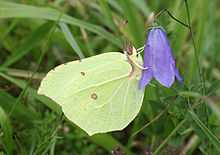Gonepteryx rhamni
| Common brimstone | |
|---|---|
_male_in_flight.jpg) | |
| Male in flight, Dry Sandford Pit, Oxfordshire | |
_male.jpg) | |
| Male at Parsonage Moor, Oxfordshire | |
| Scientific classification | |
| Kingdom: | Animalia |
| Phylum: | Arthropoda |
| Class: | Insecta |
| Order: | Lepidoptera |
| Family: | Pieridae |
| Genus: | Gonepteryx |
| Species: | G. rhamni |
| Binomial name | |
| Gonepteryx rhamni (Linnaeus, 1758) | |
Gonepteryx rhamni (known as the common brimstone) is a butterfly of the Pieridae family. It lives in Europe, North Africa and Asia. Across much of its range, it is the only species of its genus, and is therefore simply known locally as the brimstone.
Description
On the upper side the male is sulphur yellow and the female white with a greenish tinge but both have an orange spot in the centre of each wing. They never settle with their wings open and from the underside the sexes are more difficult to separate but the female is still paler. Their wing shape is unique among British butterflies (although there are similar, closely related species in southern and eastern Europe) and is designed to act as camouflage while they rest and during hibernation.
Distribution
G. rhamni lives in Europe, North Africa, South America and Asia as far east as Mongolia. It is widely distributed across the southern half of the United Kingdom, and has been steadily increasing its range in the north of England but is limited by the distribution of its larval foodplants and is quite possibly close to its maximum possible distribution now unless their foodplants' range also increases. In Ireland, it has a much more localised distribution.
Life cycle
G. rhamni is one of the longest lived butterflies, living up to thirteen months, although most of this time is spent in hibernation. As it is often the first butterfly to be seen in the spring, sometimes as early as January when hibernating adults are awoken on a sunny day, there is a popular myth that it is this butterfly which gave us the word butterfly, a corruption of butter-coloured fly.
The eggs are laid singly on the leaves of either common buckthorn (Rhamnus cathartica) or alder buckthorn (Rhamnus frangula) – the only two food plants – and females will wander far and wide in search for these particular shrubs. The larvae and pupae are both green and very well camouflaged making them difficult to find in the wild. Upon emerging from the pupae, brimstone butterflies spend the summer feeding on nectar to build up energy reserves for the winter and by the end of August they are already beginning their long sleep. They seek out evergreen scrub, a favourite being dense, old ivy growth. The brimstone usually hides until early spring, although a warm January day will occasionally wake an eager male. There is only one brood a year.

.jpg)
.jpg)
.jpg)

_male_worn.jpg)
See also
References
| Wikimedia Commons has media related to Gonepteryx rhamni. |
- Wildlife Fact File, card #63
- Jim Asher, Martin Warren & Richard Fox, ed. (2001). The Millennium Atlas of Butterflies of Britain and Ireland. Oxford University Press. ISBN 978-0-19-850565-5.